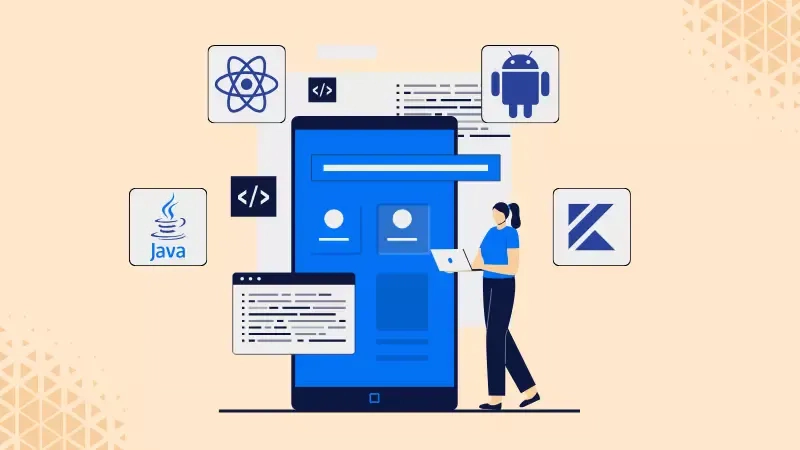
Choosing a strong technological stack throughout the app development process is essential to transforming your innovative concept into a popular mobile application. Numerous development factors, including product quality, scalability, security level, project time and budget, and so forth, are impacted by the technology stack. A poorly selected mobile app technology may cause your organization to lag months behind its competitors, while a well-chosen tech stack gives it a competitive edge and fosters growth. Software development company Codica can help with this issue; specialists will select the right technology stack.
Technology Stacks: Basics
The set of programming languages, frameworks, libraries, and tools needed to create a mobile application is referred to as a mobile app technology stack. It includes all of the client-side (frontend) and server-side (backend) software components and layers that go into creating an application.
The frontend and backend development are directly impacted by the technological stack. According to a study from Zippia,38% of consumers will cease using a cumbersome and subpar mobile app. As a result, we have identified the top technology stack for creating mobile applications in 2024.
The following are the main elements that make up a technological stack:
- Frontend: a channel via which the user and the app may communicate.
- Backend: the user interface that receives, processes, and outputs the best possible results from the user.
- Development platform: to create the mobile application, it integrates the libraries and interfaces.
- Hosting: it ensures that the server-side code executes and provides users with the apps.
Choosing the Right Stack for Your Project
Let us attempt to determine which stack best satisfies a given set of needs. When making a decision, it’s important to specify the goals and essential components of the project. This will support the team in creating the greatest product possible, satisfying every demand.
General Requirements for Applications
You must first specify the purpose of your mobile app before choosing the tech stack for development. Choosing a tech stack to construct a quick, low-latency mobile app against a high-latency application will differ significantly.
The Future Project’s Type
It’s important to choose the right project kind that may improve user experience and lead to product success while keeping the application area in mind.
Verification
You need to test your product if you want to know how end consumers will react to it. You may engage with prospective consumers by using a cross-platform strategy.
The App’s Primary Objectives
Establishing objectives is crucial. When comparing a high-latency application to a low-latency application, differences may arise in the technological stack. Additionally, compared to apps with precise and optimized interfaces, those that must manage a high load are indicative of a stronger and superior technological stack.
Data Security
Compared to other brands, many well-known corporations provide superior documentation and assistance. It’s common knowledge that Google, Adobe, and Microsoft provide excellent community support. They also provide excellent prospects for growth. It takes less time for engineers to understand topics when the community is responsive and provides clear documentation.
Scalability
The capacity of your program to handle growth spikes and seasonal changes is referred to as scalability and stability. These are crucial metrics that have the power to make or break your company because, in the current competitive landscape, users are growing less devoted.
Time
Depending on the sector or target market, it could be crucial. Certain app categories often have time constraints.
Popular Tech Stacks for Mobile Development in 2024
When preparing your app, the first thing you need to do is decide between native, cross-platform, and hybrid development.
Native App Development
Building distinct applications for each platform (iOS and Android) using tools and programming languages unique to that platform is known as native development. You will need to generate two distinct codebases in this scenario.
Java. Based on the TIOBE index, Java is the 4 most used programming language worldwide. Because of its key features—such as its comprehensive APIs, community support, adaptability, and plenty of development tools—developers choose it. Video game creation, online development, and mobile app development have all made substantial use of Java over the years.
Kotlin. One of the official languages for Android app development is Kotlin, which is endorsed by Google. Because of its complete interchange with Java and its lightweight nature, this relatively new programming language is becoming more and more popular, sometimes even being regarded as “better than Java.”
Swift.Since its release by Apple in 2014, Swift has supplanted Objective-C as the primary native programming language for developing applications for iOS, macOS, iPadOS, tvOS, and watchOS. Native iOS developers benefit from more flexibility and simplicity of use because of its interactive, compact, and expressive code. But since it’s a new programming language, it works only with macOS 10.9, iOS 7, and later versions.
Cross-Platform Development: React Native, Flutter, Xamarin
Developing an app with a single codebase that works across platforms is known as cross-platform development. Mobile engineers employ tools and frameworks made specifically for cross-platform development for this purpose.
React Native.One of the best mobile JavaScript frameworks is Facebook’s open-source UI design library. Its reusable “native components” may be immediately compiled to create native applications for iOS or Android. React Native components may also be added to existing code if you need to enhance an application without completely redoing everything. Compatibility with third-party plugins enables quicker loading times and reduced memory use while still granting access to the device’s features. The library for React Native contains support for deploying to the App Store and Google Play, debugging, inline styling, and Flexbox CSS style.
Flutter.Google offers an open-source, free UI framework called Flutter that may be used to create native mobile apps. With Flutter, developers just need to use one codebase and one programming language to build mobile apps for iOS and Android. It streamlines and expedites the process of creating iOS and Android applications.
Hybrid App Development: Ionic, Cordova/PhoneGap
Using web-based programming languages like HTML, CSS, and JavaScript, hybrid developers may design mobile applications that operate in a native shell and have an embedded web browser.
PhoneGap/Cordova. A framework called Apache Cordova makes use of HTML5 and standard JavaScript. JavaScript APIs expose native device capabilities, allowing HTML-based applications to access device-specific features like cameras and sensors. Fortunately, PhoneGap supports a wide range of frameworks and libraries, so programmers don’t have to depend just on HTML and CSS to create their user interfaces.
Ionic. Is a framework built using Angular. Hence, it preserves a community with a shared structure while sharing a wide range of benefits. Additionally, the vital feature of making hybrid applications seem native is executed well. That is to say, Ionic addresses one of the reasons for poor mobile performance by reusing DOM components.
Conclusion
The functionality and scalability of your Android or iOS app depend heavily on the mobile app tech stack you choose. Selecting the right mobile stack for a project may be challenging, particularly if you lack the necessary technical experience.
You may choose the mobile app technology stack that will guarantee your app’s outstanding performance and scalability with the assistance of an experienced tech partner. Thus, take your time in selecting a reliable outsourcing partner.
Raghav is a talented content writer with a passion for creating informative and interesting articles. With a degree in English Literature, Raghav possesses an inquisitive mind and a thirst for learning. Raghav is a fact enthusiast who loves to unearth fascinating facts from a wide range of subjects. He firmly believes that learning is a lifelong journey and he is constantly seeking opportunities to increase his knowledge and discover new facts. So make sure to check out Raghav’s work for a wonderful reading.




